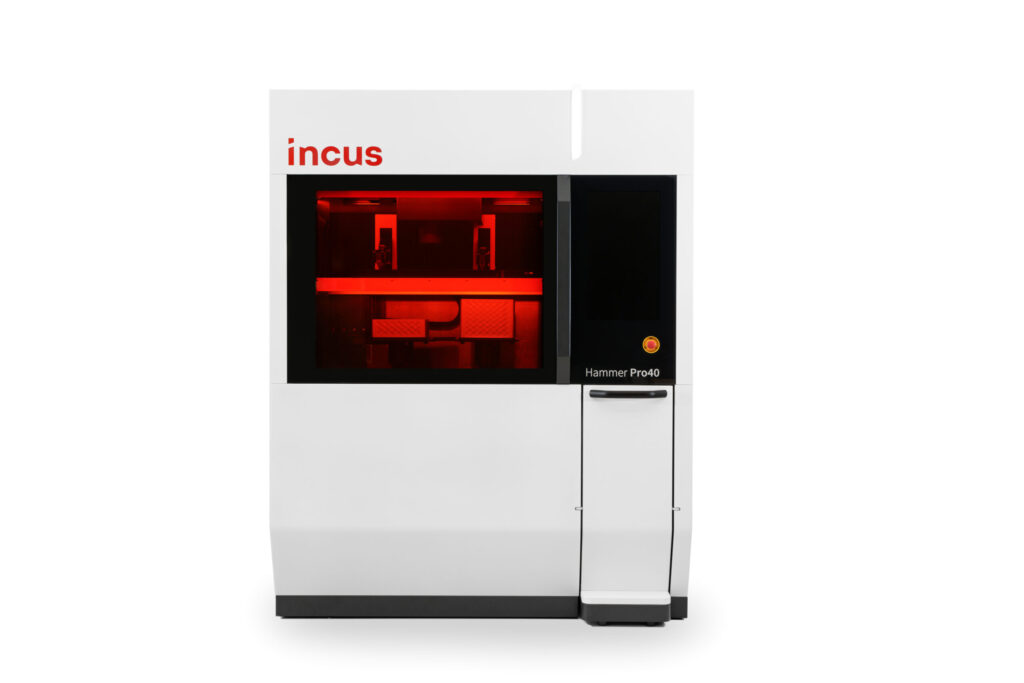Austrian 3D printing startup Incus has unveiled the Hammer Pro40, a slurry digital light processing (DLP) solution capable of creating metal parts through a combination of vat polymerization and sintering. This system is a production-focused iteration of the earlier Hammer Lab35, which was geared more towards research.
The newly introduced system boasts dual scrolling projectors, a build volume that is 600% larger, and according to the company, has the potential to print at a rate of 700cm³ per hour. Notably, this system operates at a speed seven times faster than the Lab system, while reducing the print cost per part to a quarter. Incus highlights its applicability across medical, jewelry, automotive, and robotics sectors, emphasizing its proficiency in producing small, intricate, and highly detailed components.
One of the standout features of this system is its ability to run autonomously for up to three days. Often, the turnaround times or the system turnaround itself, hampers productivity. If a build extends for several hours, there might not be personnel available to empty the printer, leaving it idle overnight. However, with the new Hammer’s capability to run continuously over the weekend and during nights, the throughput, yield, and cost per component are significantly enhanced.
Furthermore, Incus mentions that in certain instances, no additional finishing is required post printing, debinding, and sintering, claiming to achieve surface roughness values of Ra in micrometers. A common issue with parts in slurry SLA is failure during their green state while being transferred between machines. However, Incus asserts that the green state parts produced by this system are robust and are less likely to encounter this unpredictable and bothersome issue.
“The Hammer Pro40 was strategically developed to fulfill the growing demand for mass manufacturing with AM while still delivering the unique features of our technology. This innovation means a leap forward in terms of speed, precision, and cost-effectiveness, but it also opens up new opportunities to leverage the versatility of our manufacturing solution. Within a single print, you can create intricate medical gripping devices, patient-specific dental brackets, personalized jewelry pieces, prototypes for electronic devices, and customized automotive knobs for luxury interior designs – all in quantities ranging from single prototypes to mass manufacturing,” Incus CEO Dr. Gerald Mitteramskogler said.
I’m a big fan of slurry vat photopolymerization, with Incus, HoloAM, Metshape, among others, leading the charge. It leverages advancements in light technologies like DLP, and the contributions of companies like Scanlab in optic systems. At the same time, strides in chemistry and photopolymer materials are propelling it forward. At first glance, the process of infusing resin with metal or ceramic particles, then proceeding to print, debind, and sinter might seem a tad complex. It entails substantial conveyancing and the perennial challenge of shrinkage during sintering. Yet, the payoff is the creation of highly precise, cost-effective metal parts ideal for a plethora of micro-sized and specific applications.
Medical devices and instruments, for instance, align seamlessly with this technology. The ability to craft steel, precise devices to exact tolerances, at an appropriate cost and precision, bodes well for capturing a substantial market share in the expanding medical device sector—a trend likely to sustain for a considerable duration. As electronics continue to miniaturize while amplifying their potency, the accompanying cases, assemblies, and devices are necessitated to downsize. It’s within this burgeoning domain where other 3D printing technologies fall short, unable to match the quality, cost, and size achievable through slurry SLA.
What also captivates me about this technology is its capability to fashion exceptionally smooth flow channels, making it a prized choice for heat exchangers, tools, and other precise flow components. This transition from laboratory to manufacturing is a promising stride, auguring well for this facet of the industry.
